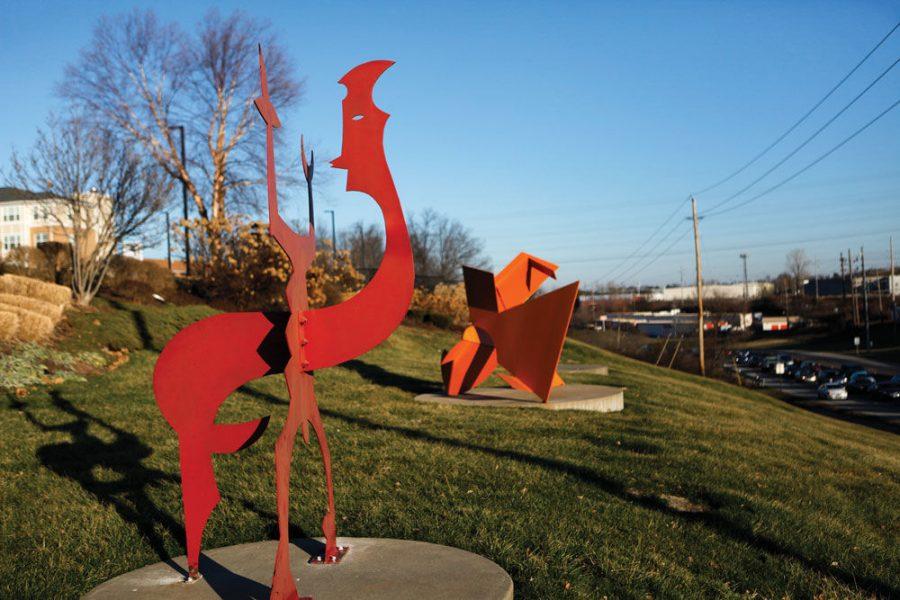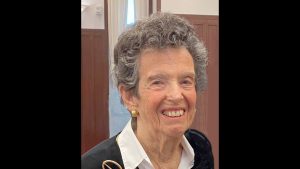Public art a highlight of reborn Millstone Campus
Published January 9, 2020
As he takes a reporter on a tour of the art at the I.E. Millstone Campus near Creve Coeur, Michael Staenberg beams with pride. The Jewish philanthropist and developer resembles a proud papa, although in this case his offspring are 215 pieces of art, valued at more than $1 million and representing roughly 50 artists, that he donated to the Jewish Community Center.
He also donated or loaned 27 other pieces, worth more than $150,000, to the Jewish Federation’s Kaplan Feldman Complex.
“I get the art from all over,” said Staenberg, who contributed tens of millions of dollars to remake the Millstone campus over the past 10 years. “I buy every piece myself. I call and look and travel all over to find the right pieces, and I’ve commissioned some of the pieces you see to fit certain spaces. Much of the art either reflects a Jewish theme or was created by a Jewish artist.”
In addition to Staenberg, the JCA Charitable Foundation has donated more than 100 works of art to Covenant Place, a senior housing facility on the Millstone campus. Many of these pieces once adorned the walls and hallways of the Jewish Center for Aged and its successor, the Cedars, but then went into storage after Lutheran Senior Services bought the facility in 2016.
Alice Handelman, who served as director of community relations for the Jewish Center for Aged for 18 years, helped acquire the art from its original donors and pushed for the art to be donated to Covenant Place because “the intention always was for the art to stay in the Jewish community,” she said.
Ken Rubin, president of JCA Charitable, which owned the art, agreed.
“We felt donating it to Covenant Place was honoring that intent, to enrich the lives of senior adults,” he said.
Joan Denison, executive director of Covenant, couldn’t be more grateful, adding that “art lights people’s spirits” and can be especially uplifting to an aging population.
“As we age and there is cognitive change, art hits us at a place that’s deeper and connects with people at an emotional level,” she said. “It’s like music. It goes into a different part of the brain and can evoke wonderful feelings even as people have cognitive decline and other changes.”
Denison said the artwork throughout Covenant I and II senior apartment buildings, as well as in the Mirowitz Center that houses HJ’s Café, has been carefully curated so that each piece fits the space it is in. The rooms used for exercise, for example, have pieces that evoke energy and vibrancy; paintings in the café have themes of dining and social interaction.
“The art is the jewelry of the property,” she said. “The buildings are new and very pretty but when the art is hung, it’s the accessory that makes the place sparkle and gives it life.”
Staenberg is on the hunt for outdoor art to complement the exterior of Covenant Place. He says these public art pieces are vital because they connect and enhance the community buildings as well as the landscape.
“Many people don’t realize that there are (St. Louis-based Ernest) Trova sculptures in front of the entrance to the Millstone campus along Lindbergh (Boulevard) and Schuetz (Road),” he said. “There were nine of them sitting in storage in the basement of Federation. We had them repainted and refurbished. They are magnificent.”
While Staenberg says he has no favorite piece of art, the Jerusalem Sphere, a large-scale sculpture that welcomes visitors in the lobby of the J’s Arts and Education building, is one work he greatly admires. Israeli artist Frank Meisler created the cast-metal rotating sphere. According to the artist’s website, “The sculpture depicts the spirit of the city (of Jerusalem), its ancient walls and buildings of many styles, periods and cultures.”
Staenberg said he wanted to make sure that several Israeli artists were part of the collection on campus, adding that he purchased Meisler’s Jerusalem Sphere for $40,000. Today, he says, it is valued in excess of $100,000.
“People don’t always know why they like a piece of art, whether it’s the shape or colors or the subject matter or the mood it evokes,” he said. “What I have found is that art is nuance. It enhances our feelings.”
As he walks around the J complex, Staenberg points out how the tile floors and signage is art, too. A “Welcome to the St. Louis Jewish Community Center” sign in front of the Staenberg Family Complex, for instance, features several metal figures either engaged in sport or relating to one another. It’s both welcoming and beautiful, Staenberg said.
“I saw something like this in San Francisco, and I wanted it for the J,” he said. “So I contacted the artist and had him create it and several other pieces.”
Staenberg also commissioned a remarkable sculpture that hangs from the ceiling in the atrium lobby at Federation’s Kaplan Feldman Complex.
Mark Salsbury of Third Degree Glass installed the colorful, large-scale glass mobile of various circular shapes “to convey a balance between complex patterns and simple forms,” heexplained. Depending on where you stand and how the glass reflects the light, the colors change and the forms look different.
Don Hannon, chief operating officer at Federation, said that even before an architect was hired to redo the Federation building, Staenberg and Andrew Rehfeld, former CEO and president of Federation, were emphatic that the building’s community spaces be especially inviting.
“(Staenberg) was really active in this project and in helping us create a look and feel that makes this building come alive,” Hannon said. “The art is intrinsically tied to that. It provides that pop. There is much more energy in the building now and a marked increase in community groups using it.”















